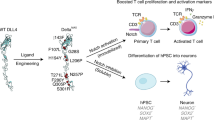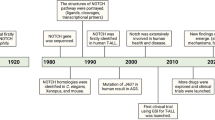Abstract
Notch is a cell-surface receptor that controls cell-fate decisions and is regulated by O-glycans attached to epidermal growth factor-like (EGF) repeats in its extracellular domain. Protein O-fucosyltransferase 1 (Pofut1) modifies EGF repeats with O-fucose and is essential for Notch signaling. Constitutive activation of Notch signaling has been associated with a variety of human malignancies. Therefore, tools that inhibit Notch activity are being developed as cancer therapeutics. To this end, we screened L-fucose analogs for their effects on Notch signaling. Two analogs, 6-alkynyl and 6-alkenyl fucose, were substrates of Pofut1 and were incorporated directly into Notch EGF repeats in cells. Both analogs were potent inhibitors of binding to and activation of Notch1 by Notch ligands Dll1 and Dll4, but not by Jag1. Mutagenesis and modeling studies suggest that incorporation of the analogs into EGF8 of Notch1 markedly reduces the ability of Delta ligands to bind and activate Notch1.
This is a preview of subscription content, access via your institution
Access options
Access Nature and 54 other Nature Portfolio journals
Get Nature+, our best-value online-access subscription
$29.99 / 30 days
cancel any time
Subscribe to this journal
Receive 12 print issues and online access
$259.00 per year
only $21.58 per issue
Buy this article
- Purchase on Springer Link
- Instant access to full article PDF
Prices may be subject to local taxes which are calculated during checkout






Similar content being viewed by others
References
Artavanis-Tsakonas, S., Rand, M.D. & Lake, R.J. Notch signaling: cell fate control and signal integration in development. Science 284, 770–776 (1999).
Hori, K., Sen, A. & Artavanis-Tsakonas, S. Notch signaling at a glance. J. Cell Sci. 126, 2135–2140 (2013).
Kopan, R. & Ilagan, M.X.G. The canonical Notch signaling pathway: unfolding the activation mechanism. Cell 137, 216–233 (2009).
Teodorczyk, M. & Schmidt, M.H. Notching on cancer's door: Notch signaling in brain tumors. Front. Oncol. 4, 341 (2015).
Wu, G., Wilson, G., George, J. & Qiao, L. Modulation of Notch signaling as a therapeutic approach for liver cancer. Curr. Gene Ther. 15, 171–181 (2015).
Espinoza, I., Pochampally, R., Xing, F., Watabe, K. & Miele, L. Notch signaling: targeting cancer stem cells and epithelial-to-mesenchymal transition. Onco Targets Ther. 6, 1249–1259 (2013).
Yin, L., Velazquez, O.C. & Liu, Z.-J. Notch signaling: emerging molecular targets for cancer therapy. Biochem. Pharmacol. 80, 690–701 (2010).
Wu, Y. et al. Therapeutic antibody targeting of individual Notch receptors. Nature 464, 1052–1057 (2010).
Sagert, J. et al. Tumor-specific inhibition of jagged-dependent notch signaling using a Probody therapeutic. Mol. Cancer Ther. 12, abstr. C158 (2013).
Tran, I.T. et al. Blockade of individual Notch ligands and receptors controls graft-versus-host disease. J. Clin. Invest. 123, 1590–1604 (2013).
Lafkas, D. et al. Therapeutic antibodies reveal Notch control of transdifferentiation in the adult lung. Nature 528, 127–131 (2015).
Wharton, K.A., Johansen, K.M., Xu, T. & Artavanis-Tsakonas, S. Nucleotide sequence from the neurogenic locus notch implies a gene product that shares homology with proteins containing EGF-like repeats. Cell 43, 567–581 (1985).
Luca, V.C. et al. Structural biology. Structural basis for Notch1 engagement of Delta-like 4. Science 347, 847–853 (2015).
Moloney, D.J. et al. Mammalian Notch1 is modified with two unusual forms of O-linked glycosylation found on epidermal growth factor-like modules. J. Biol. Chem. 275, 9604–9611 (2000).
Matsuura, A. et al. O-linked N-acetylglucosamine is present on the extracellular domain of notch receptors. J. Biol. Chem. 283, 35486–35495 (2008).
Shi, S. & Stanley, P. Protein O-fucosyltransferase 1 is an essential component of Notch signaling pathways. Proc. Natl. Acad. Sci. USA 100, 5234–5239 (2003).
Moloney, D.J. et al. Fringe is a glycosyltransferase that modifies Notch. Nature 406, 369–375 (2000).
Brückner, K., Perez, L., Clausen, H. & Cohen, S. Glycosyltransferase activity of Fringe modulates Notch-Delta interactions. Nature 406, 411–415 (2000).
Rillahan, C.D. et al. Global metabolic inhibitors of sialyl- and fucosyltransferases remodel the glycome. Nat. Chem. Biol. 8, 661–668 (2012).
Okeley, N.M. et al. Development of orally active inhibitors of protein and cellular fucosylation. Proc. Natl. Acad. Sci. USA 110, 5404–5409 (2013).
Sawa, M. et al. Glycoproteomic probes for fluorescent imaging of fucosylated glycans in vivo. Proc. Natl. Acad. Sci. USA 103, 12371–12376 (2006).
Al-Shareffi, E. et al. 6-alkynyl fucose is a bioorthogonal analog for O-fucosylation of epidermal growth factor-like repeats and thrombospondin type-1 repeats by protein O-fucosyltransferases 1 and 2. Glycobiology 23, 188–198 (2013).
Parsons, M.J. et al. Notch-responsive cells initiate the secondary transition in larval zebrafish pancreas. Mech. Dev. 126, 898–912 (2009).
Ohata, S. et al. Neuroepithelial cells require fucosylated glycans to guide the migration of vagus motor neuron progenitors in the developing zebrafish hindbrain. Development 136, 1653–1663 (2009).
Okajima, T., Xu, A. & Irvine, K.D. Modulation of notch-ligand binding by protein O-fucosyltransferase 1 and fringe. J. Biol. Chem. 278, 42340–42345 (2003).
Herrmann, M., von der Lieth, C.W., Stehling, P., Reutter, W. & Pawlita, M. Consequences of a subtle sialic acid modification on the murine polyomavirus receptor. J. Virol. 71, 5922–5931 (1997).
Descheny, L., Gainers, M.E., Walcheck, B. & Dimitroff, C.J. Ameliorating skin-homing receptors on malignant T cells with a fluorosugar analog of N-acetylglucosamine: P-selectin ligand is a more sensitive target than E-selectin ligand. J. Invest. Dermatol. 126, 2065–2073 (2006).
Gloster, T.M. et al. Hijacking a biosynthetic pathway yields a glycosyltransferase inhibitor within cells. Nat. Chem. Biol. 7, 174–181 (2011).
Hicks, C. et al. Fringe differentially modulates Jagged1 and Delta1 signalling through Notch1 and Notch2. Nat. Cell Biol. 2, 515–520 (2000).
Taylor, P. et al. Fringe-mediated extension of O-linked fucose in the ligand-binding region of Notch1 increases binding to mammalian Notch ligands. Proc. Natl. Acad. Sci. USA 111, 7290–7295 (2014).
Kakuda, S. & Haltiwanger, R.S. Deciphering the fringe-mediated notch code: identification of activating and inhibiting sites allowing discrimination between ligands. Dev. Cell 40, 193–201 (2017).
Yang, L.-T. et al. Fringe glycosyltransferases differentially modulate Notch1 proteolysis induced by Delta1 and Jagged1. Mol. Biol. Cell 16, 927–942 (2005).
Müller, J. et al. O-fucosylation of the notch ligand mDLL1 by POFUT1 is dispensable for ligand function. PLoS One 9, e88571 (2014).
Panin, V.M. et al. Notch ligands are substrates for protein O-fucosyltransferase-1 and Fringe. J. Biol. Chem. 277, 29945–29952 (2002).
Luca, V.C. et al. Notch-Jagged complex structure implicates a catch bond in tuning ligand sensitivity. Science 355, 1320–1324 (2017).
Song, Y., Kumar, V., Wei, H.-X., Qiu, J. & Stanley, P. Lunatic, manic, and radical fringe each promote T and B cell development. J. Immunol. 196, 232–243 (2016).
Andrawes, M.B. et al. Intrinsic selectivity of Notch 1 for Delta-like 4 over Delta-like 1. J. Biol. Chem. 288, 25477–25489 (2013).
Sawaguchi, S. et al. O-GlcNAc on NOTCH1 EGF repeats regulates ligand-induced Notch signaling and vascular development in mammals. eLife 6, e24419 (2017).
Hiruma-Shimizu, K. et al. Chemical synthesis, folding, and structural insights into O-fucosylated epidermal growth factor-like repeat 12 of mouse Notch-1 receptor. J. Am. Chem. Soc. 132, 14857–14865 (2010).
Lira-Navarrete, E. et al. Structural insights into the mechanism of protein O-fucosylation. PLoS One 6, e25365 (2011).
Rana, N.A. et al. O-glucose trisaccharide is present at high but variable stoichiometry at multiple sites on mouse Notch1. J. Biol. Chem. 286, 31623–31637 (2011).
Harvey, B.M. et al. Mapping sites of O-glycosylation and fringe elongation on Drosophila Notch. J. Biol. Chem. 291, 16348–16360 (2016).
Stanley, P. & Guidos, C.J. Regulation of Notch signaling during T- and B-cell development by O-fucose glycans. Immunol. Rev. 230, 201–215 (2009).
Aster, J.C., Pear, W.S. & Blacklow, S.C. The varied roles of notch in cancer. Annu. Rev. Pathol. 12, 245–275 (2016).
Purow, B.W. et al. Expression of Notch-1 and its ligands, Delta-like-1 and Jagged-1, is critical for glioma cell survival and proliferation. Cancer Res. 65, 2353–2363 (2005).
Ridgway, J. et al. Inhibition of Dll4 signalling inhibits tumour growth by deregulating angiogenesis. Nature 444, 1083–1087 (2006).
Sawey, E.T. et al. Identification of a therapeutic strategy targeting amplified FGF19 in liver cancer by Oncogenomic screening. Cancer Cell 19, 347–358 (2011).
Ma, L. et al. Overexpression of protein O-fucosyltransferase 1 accelerates hepatocellular carcinoma progression via the Notch signaling pathway. Biochem. Biophys. Res. Commun. 473, 503–510 (2016).
Yokota, S. et al. Protein O-fucosyltransferase 1: a potential diagnostic marker and therapeutic target for human oral cancer. Int. J. Oncol. 43, 1864–1870 (2013).
Kimmel, C.B., Ballard, W.W., Kimmel, S.R., Ullmann, B. & Schilling, T.F. Stages of embryonic development of the zebrafish. Dev. Dyn. 203, 253–310 (1995).
White, R.M. et al. Transparent adult zebrafish as a tool for in vivo transplantation analysis. Cell Stem Cell 2, 183–189 (2008).
Nye, J.S., Kopan, R. & Axel, R. An activated Notch suppresses neurogenesis and myogenesis but not gliogenesis in mammalian cells. Development 120, 2421–2430 (1994).
Shimizu, K. et al. Mouse jagged1 physically interacts with notch2 and other notch receptors. Assessment by quantitative methods. J. Biol. Chem. 274, 32961–32969 (1999).
Thomas, M. et al. Full deacylation of polyethylenimine dramatically boosts its gene delivery efficiency and specificity to mouse lung. Proc. Natl. Acad. Sci. USA 102, 5679–5684 (2005).
Kakuda, S. & Haltiwanger, R.S. Analyzing the posttranslational modification status of Notch using mass spectrometry. Methods Mol. Biol. 1187, 209–221 (2014).
Yamamoto, S. et al. A mutation in EGF repeat-8 of Notch discriminates between Serrate/Jagged and Delta family ligands. Science 338, 1229–1232 (2012).
Rana, N.A. & Haltiwanger, R.S. Fringe benefits: functional and structural impacts of O-glycosylation on the extracellular domain of Notch receptors. Curr. Opin. Struct. Biol. 21, 583–589 (2011).
Van de Walle, I. et al. Jagged2 acts as a Delta-like Notch ligand during early hematopoietic cell fate decisions. Blood 117, 4449–4459 (2011).
Acknowledgements
This work was supported by NIH grants R01GM061126 (R.S.H.), R01GM093282 (P.W.), R01GM106417 (P.S.) and K99CA204738 (V.C.L.). M.S. was partially supported by T32GM00844. We thank the following for providing materials: J. Nye (Northwestern University Medical School), S. Chiba (University of Tokyo), G. Bornkamm (Helmholtz Zentrum Munchen), G. Weinmater (UCLA), S. Blacklow (Harvard), S. Kakuda (Stony Brook University), and C. Guidos (University of Toronto).
Author information
Authors and Affiliations
Contributions
M.S., P.W. and R.S.H. conceived experiments, analyzed and interpreted data and wrote the paper. L.U.N. synthesized fucose analogs. M.S., V.K., L.F., H.T. and H.H. designed and performed experiments. V.C.L. and K.C.G. constructed structural models. P.S. and P.W. helped design experiments, interpret data and revise the manuscript.
Corresponding authors
Ethics declarations
Competing interests
The authors declare no competing financial interests.
Supplementary information
Supplementary Text and Figures
Supplementary Results, Supplementary Figures 1–9 (PDF 9748 kb)
Supplementary Note 1
Supplementary Note 1 (PDF 4146 kb)
Supplementary Note 2
Synthetic protocols (PDF 1200 kb)
Rights and permissions
About this article
Cite this article
Schneider, M., Kumar, V., Nordstrøm, L. et al. Inhibition of Delta-induced Notch signaling using fucose analogs. Nat Chem Biol 14, 65–71 (2018). https://doi.org/10.1038/nchembio.2520
Received:
Accepted:
Published:
Issue Date:
DOI: https://doi.org/10.1038/nchembio.2520
This article is cited by
-
Angiogenic signaling pathways and anti-angiogenic therapy for cancer
Signal Transduction and Targeted Therapy (2023)
-
Targeting Notch in oncology: the path forward
Nature Reviews Drug Discovery (2021)
-
POFUT1 acts as a tumor promoter in glioblastoma by enhancing the activation of Notch signaling
Journal of Bioenergetics and Biomembranes (2021)
-
A sweet strategy
Nature Chemical Biology (2018)



